Because runners with different arch heights are prone to different injuries, running shoe manufacturers have developed motion-control, stability and cushion running shoes for low-, neutral- and high-arched runners, respectively. (Fig. 1)
In order to improve shock absorption, the midsoles in cushion running shoes are significantly softer. To fit runners with neutral feet, stability running shoes are made with semi-curved lasts and only a moderate amount of midsole cushioning.
For more than 30 years, running shoe manufacturers have suggested that prescribing running shoes based on arch height will reduce injury rates and increase comfort. Surprisingly, despite the fact that consumers have spent billions of dollars for just the right running shoe, there is conflicting evidence suggesting the prescription of running shoes based on arch height is clinically justified.
Arch Height, Shoe Type and Injury Rates
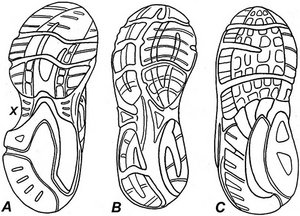 Fig. 1. Bottom view of the three basic types of running shoes. Cushion running shoes (A) are made for individuals with high arches. They are slightly curved to match the shape of the typical high-arched foot and possess fl exible midsoles with signifi cantly less bulk in the midfoot region (X). The reduced midsole material in the midfoot gives the shoe an hourglass appearance when viewed from below. Stability sneakers (B) are made for individuals with neutral foot types. They are straighter and have slightly more midsole material reinforced beneath the arch. In contrast, motion-control sneakers (C) are very straight and are strongly reinforced throughout the midfoot with extra-thick midsole material. Because of the additional midsole material, motion-control sneakers are extremely stiff.
In one of the largest studies done to date, Knapik, et al.,1 divided 1,400 male and female Marine Corps recruits into two groups: an experimental group in which running shoe recommendation was based on arch height, and a control group that wore neutral stability running shoes regardless of arch height. After the subjects completed an intensive 12-week training regimen, the authors concluded that prescribing running shoes according to arch height was not necessary, since there was no difference in injury rates between the two groups.
Fig. 1. Bottom view of the three basic types of running shoes. Cushion running shoes (A) are made for individuals with high arches. They are slightly curved to match the shape of the typical high-arched foot and possess fl exible midsoles with signifi cantly less bulk in the midfoot region (X). The reduced midsole material in the midfoot gives the shoe an hourglass appearance when viewed from below. Stability sneakers (B) are made for individuals with neutral foot types. They are straighter and have slightly more midsole material reinforced beneath the arch. In contrast, motion-control sneakers (C) are very straight and are strongly reinforced throughout the midfoot with extra-thick midsole material. Because of the additional midsole material, motion-control sneakers are extremely stiff.
In one of the largest studies done to date, Knapik, et al.,1 divided 1,400 male and female Marine Corps recruits into two groups: an experimental group in which running shoe recommendation was based on arch height, and a control group that wore neutral stability running shoes regardless of arch height. After the subjects completed an intensive 12-week training regimen, the authors concluded that prescribing running shoes according to arch height was not necessary, since there was no difference in injury rates between the two groups.
In another study evaluating the value of prescribing running shoes according to arch height, Ryan, et al.,2 categorized 81 female runners as supinators, neutral or pronators, and then randomly assigned them to wear neutral, stability or motion-control running shoes. Again, the authors concluded that there was no correlation between foot type, running shoe use and the frequency of reported pain.
One of the more interesting findings of this research was that the individuals classified as pronators reported greater levels of pain when wearing the motion-control running shoes. This is consistent with the hypothesis that excessive midsole thickness may dampen sensory input, amplifying the potential for injury because the athlete can't "feel the ground."
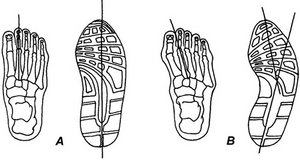 Fig. 2. Straight and curve-lasted sneakers. The "last" refers to the foot-shaped mold a running shoe is constructed around. A straight-lasted shoe is well-aligned in the forefoot and rearfoot, and is recommended for individuals with straight feet (A). Curve-lasted shoes are angled inward at the forefoot and are typically worn by high-arched runners whose forefeet tilt inward (B).
Supporting the belief that running shoe prescription should continue to be based on arch height, several high-quality laboratory studies have shown that the different types of running shoes actually do what they are supposed to do: Motion-control running shoes have been proven to limit pronation, and cushion running shoes have been proven to improve shock absorption.
Fig. 2. Straight and curve-lasted sneakers. The "last" refers to the foot-shaped mold a running shoe is constructed around. A straight-lasted shoe is well-aligned in the forefoot and rearfoot, and is recommended for individuals with straight feet (A). Curve-lasted shoes are angled inward at the forefoot and are typically worn by high-arched runners whose forefeet tilt inward (B).
Supporting the belief that running shoe prescription should continue to be based on arch height, several high-quality laboratory studies have shown that the different types of running shoes actually do what they are supposed to do: Motion-control running shoes have been proven to limit pronation, and cushion running shoes have been proven to improve shock absorption.
To prove this, researchers measured arch height and evaluated impact forces, tibial accelerations, and the range and speed of pronation after high- and low-arched runners were randomly assigned to wear cushion and motion-control running shoes.3 The detailed analysis confirmed that motion-control running shoes do, in fact, control rearfoot motion better than cushion running shoes; and cushion running shoes attenuate shock better than motion-control running shoes.
In a study evaluating the effect of motion-control versus neutral shoes on overpronators, Cheung and Ng4 used electrical devices to measure muscle activity as subjects ran 10 kilometers. The authors noted that when wearing motion-control shoes, runners who pronated excessively reported reduced muscular fatigue in the front and sides of their legs.
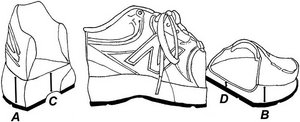 Fig. 3. The heel-toe drop. Most manufacturers provide information regarding the thickness of the midsole along its outer margins (A and B), not beneath the center the forefoot and rearfoot (C and D). Measurements of midsole thickness taken directly beneath the foot are much different. In the above New Balance 860, which was cut into pieces, the manufacturer's listed thickness of the rearfoot and forefoot is 38 mm and 26 mm, respectively. In reality, the measured thickness beneath the heel and forefoot is 22 mm and 11 mm, respectively – a heel-toe drop of 11 mm.
In a separate study of excessive supinators, Wegener, et al.,5 evaluated pressure along the bottom of the foot when high-arched individuals wore either cushion running shoes or motion-control shoes. The authors confirmed that the cushion running shoes more effectively distributed pressure and were perceived as being more comfortable than the motion-control running shoes.
Fig. 3. The heel-toe drop. Most manufacturers provide information regarding the thickness of the midsole along its outer margins (A and B), not beneath the center the forefoot and rearfoot (C and D). Measurements of midsole thickness taken directly beneath the foot are much different. In the above New Balance 860, which was cut into pieces, the manufacturer's listed thickness of the rearfoot and forefoot is 38 mm and 26 mm, respectively. In reality, the measured thickness beneath the heel and forefoot is 22 mm and 11 mm, respectively – a heel-toe drop of 11 mm.
In a separate study of excessive supinators, Wegener, et al.,5 evaluated pressure along the bottom of the foot when high-arched individuals wore either cushion running shoes or motion-control shoes. The authors confirmed that the cushion running shoes more effectively distributed pressure and were perceived as being more comfortable than the motion-control running shoes.
The results of the previously listed studies suggest the practice of prescribing running shoes based on arch height has merit, particularly for people on the far ends of the arch height spectrum.
Which Running Shoe? The Most Important Factors to Consider
When you look at all of the research evaluating running shoe prescription and injury, it becomes clear that the most important factors to consider when selecting a running shoe are that it fits the foot perfectly (width, length and shape), and that the midsole is comfortable. The size of the shoe is determined by matching the widest part of the forefoot to the widest part of the toe box, and there should be a few millimeters of space between the tip of the longest toe and the end of the running shoe. The shoe's upper also should comfortably fit the shape of the foot.
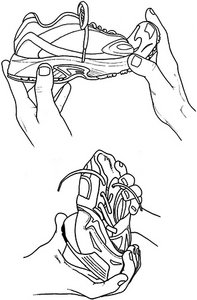 Fig. 4. Evaluating midsole stiffness.
An important factor to consider when prescribing a running shoe is that the midsole should also be selected in part by your patient's running style: Heel strikers often need additional cushioning beneath the rearfoot, while midfoot strikers typically prefer zero-drop midsoles. (Fig. 3)
Fig. 4. Evaluating midsole stiffness.
An important factor to consider when prescribing a running shoe is that the midsole should also be selected in part by your patient's running style: Heel strikers often need additional cushioning beneath the rearfoot, while midfoot strikers typically prefer zero-drop midsoles. (Fig. 3)
In almost all situations, even extremely flat-footed runners should think twice about wearing heavy motion- control running shoes because they may dampen sensory input from the foot, and their extreme stiffness often results in ankle and/or knee injuries.
In order to identify the midsole that is right for your patient, have them experiment with a range of running shoes until they find just the right thickness, stiffness and downward slope.
Though rarely discussed, perhaps the most important attribute of a midsole is its overall stiffness. In my experience, the stiffness of a running shoe midsole is the most important factor associated with comfort and injury prevention. You can easily evaluate midsole stiffness by twisting it in several directions while grabbing the heel and forefoot.
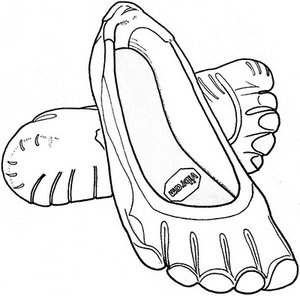 Fig. 5. "Barefoot" running shoes are designed to mimic barefoot activity. Unfortunately, because these shoes lack adequate midsole material, they are unable to protect the plantar foot from trauma and recent research confirms significantly higher injury rates in runners transitioning to minimalist shoe wear.6-7
There is a surprising amount of variation in midsole stiffness, as running shoes will bend with anywhere from 5-50 pounds of force. (Fig. 4) The best running shoes will bend with very little pressure, allowing your feet to move freely in all directions.
Fig. 5. "Barefoot" running shoes are designed to mimic barefoot activity. Unfortunately, because these shoes lack adequate midsole material, they are unable to protect the plantar foot from trauma and recent research confirms significantly higher injury rates in runners transitioning to minimalist shoe wear.6-7
There is a surprising amount of variation in midsole stiffness, as running shoes will bend with anywhere from 5-50 pounds of force. (Fig. 4) The best running shoes will bend with very little pressure, allowing your feet to move freely in all directions.
Unfortunately, manufacturers rarely provide information regarding overall stiffness, and it is important for runners to know the precise degree of midsole stiffness that is most comfortable for them. High-arched runners tend to be drawn to extremely flexible midsoles, while low-arched runners usually prefer a slightly stiffer midsole. The extremely stiff midsoles are almost universally uncomfortable.
The bottom line with all the research on running shoe prescription is that your patient is always the best judge of which running shoe is right for them. From a chiropractic perspective, the heavy motion-control shoes should rarely be prescribed because they may interfere with proprioception. Conversely, the minimalist running shoes, such as the "five-finger" running shoes (Fig. 5), are too thin to provide adequate protection and have recently been proven to produce very high injury rates.6-7 As a general rule, most runners will do best with lightweight stability shoes that match the shape of their feet.
References
- Knapik J, Trone D, Swedler D, et al. Injury reduction effectiveness of assigning running shoes based on plantar shaped in Marine Corps basic training. Am J Sports Med, 2010;38:1759-1767.
- Ryan M, Valiant G, McDonald K, Taunton J. The effect of three different levels of footwear stability on pain outcomes in women runners: a randomized control trial. Br J Sports Med, July 2011;45(9):715-21.
- Butler R, Davis I, Hamill J. Interaction of arch type and footwear on running mechanics. Am J Sports Med, 2006;34:1998.
- Cheung R, Ng G. Motion control shoe delays fatigue of shank muscles in runners with overpronating feet. Am J Sports Med, 2010;38:486.
- Wegener C, Burns J, Penkala S. Neutral-cushioned running shoes on plantar pressure loading and comfort in athletes with cavus feet: a crossover randomized controlled trial. Am J Sports Med, 2008;36:2139.
- Ridge S, Johnson A, Mitchell U, et al. Foot bone marrow edema after 10-week transition to minimalist running shoes. Med Sci Sports & Exerc, July 2013;45(7):1363-68.
- Ryan M, Elashi M, Newsham-West R, Taunton J. Examining injury risk and pain perception in runners using minimalist footwear. Br J Sports Med, Dec. 19, 2013; epub ahead of print.
Click here for more information about Thomas Michaud, DC.





